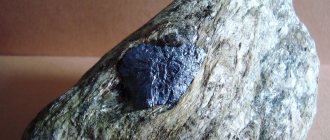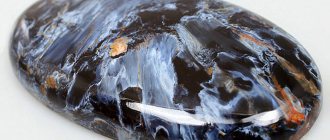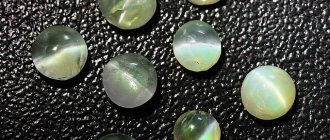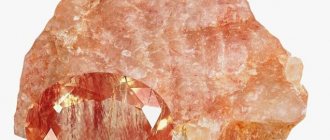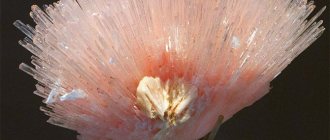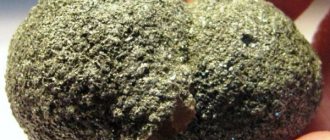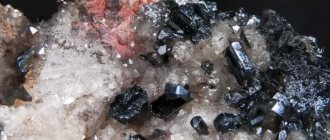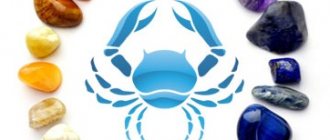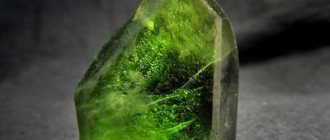Native silver, its properties and influence have been known since Ancient times; it had special significance for many peoples. It was widely used to treat diseases, make dishes, jewelry, and was also used to purify water.
Description and external signs
There are many legends and interesting facts associated with the search and discovery of silver. One thing that remains surprising is that native silver is rare, but the amount discovered is colossal, up to 1000 tons. It is formed together with various impurities of chemical elements:
- iron;
- zinc;
- bromine;
- chrome;
- copper;
- mercury;
- gold;
- chlorine;
- iodine;
- antimony;
- nickel;
- bismuth;
- cobalt;
- nickel;
- uranium.
Regular silver is mined by removing impurities from other metals after processing the ore from the deposit. Native silver, depending on impurities and the location of discovery, as well as the influence of external factors, is silver-white in color, with a black, dark gray, yellow or brown coating. The metal is ductile and inferior in hardness to gold and platinum.
Native silver (Ag, Argentum) belongs to the class of native elements, opaque with a metallic luster, in the periodic table it is number 47, in the group of transition metals No. 11.
The name was derived from the Sanskrit word “argant”, which translates as “light, white”. Also, many scientists believe that the word “silver” comes from “sapra - Moon”, because ancient peoples associated gold with the sun, and silver with the moon.
Historical nuances and interesting facts
The Italian traveler and navigator Sebastian Cabot (1476-1557) sailed to Argentina in the 16th century with the aim of exploring and finding new passages and routes for travel, as well as drawing maps. While climbing one of the large rivers, he noticed that the local population had many silver items in their everyday use; after his expedition, he told his European colleagues about this fact.
Subsequently, scientific expeditions were organized and reserves of native silver were discovered, but in small quantities. The river along which S. Cabot sailed was named La Plata (Silver), and the country was also called “Silver”, several decades later it was renamed after the chemical element of silver “Argentum - Argentina”.
In Ancient Egypt, native silver was considered a valuable metal, it was called “white gold,” and jewelry that was created from it cost fabulous money. Alchemists gave special honor to silver, who for many centuries searched for a way to create gold from other elements, so Ag was the most suitable element for transformations.
In ancient Rome, only rich or noble people could have silver objects; items made from it were considered a luxury and were very expensive.
In ancient times, silver did not bypass Rus', where it was more often used for mutual settlements for purchased and sold goods, but the peculiarity of such payment was that silver was fused into small ingots. If the ingot was worth more than the product being purchased, it was “chopped” into several parts or in half, subsequently the Russian monetary unit was called the “ruble”.
There are a lot of historical facts about the use of silver; it was used by folk healers, monks, magicians, and statesmen. The property of purifying water was noticed if silver objects were dipped into it. Church leaders and magicians consider silver to protect a person from evil spirits, because it is not in vain that the pectoral cross should be made of silver.
Argentum production and locations
Silver mining occurs in places where ores occur complexly or in private deposits. More than 70% is extracted from complex non-ferrous metal mines and processed, releasing 10 kg per ton. Argentum often occurs in caustobolites (coal, oil, shale, peat).
Found in low temperature hydrothermal vents and oxidation zones of sulfide deposits. Silver is formed in the surface layers of the earth's crust under the influence of external factors and in deep layers (exogenous and endogenous methods). More than 80% of silver production comes from extraction as a by-product in mines with lead, gold, and copper.
According to the Silver Institute, the leading countries mining this mineral were identified:
- 20% of production comes from Mexico;
- 18% China;
- 16% USA;
- 14% Peru;
- 12% Chile;
- 8% Australia;
- 6% Russia;
- 4% Argentina;
- 2% Kazakhstan.
A number of other countries also have small deposits of silver, accounting for 1% of production.
- Spain;
- Germany;
- Armenia;
- Hungary;
- New Zealand;
- Uruguay;
- Canada;
- Poland;
- Ukraine;
- Austria;
- Slovakia;
- Norway;
- Sweden;
- Cyprus;
- Romania;
- Japan;
- O. Sardinia.
Accompanies the minerals dolomite, calcite, aragonite, argentite, lead, galena.
Classification
Native silver is classified depending on chemical impurities in percentage:
- native silver, contained 90-99% in the found specimen;
- native gold (electrum) containing more gold than silver;
- kustelite contains more silver than gold
- argentite (with an admixture of sulfur);
- dyscrazite (with antimony);
- stephanite (more than 60% silver + antimony and sulfur);
- pyrargyrite (55%-60% silver + antimony, sulfur);
- kerargyrite (with chlorine);
- bromargerite (with bromine);
- freibergite (about 40% silver +% with copper, sulfur, antimony, iron, arsenic);
- argentoyarosite (with iron and sulfur);
- polybasite (with copper, antimony, sulfur);
- proustite (with arsenic and sulfur);
- aguilarite (with selenium and sulfur).
Impurities can be in different proportions and there are more than 50 types of native silver, but about 15 types are suitable for industrial use.
Mining and reserves of silver in the world. 2011-2012
| A country | Production in 2011, tons | Production in 2012, tons | Reserves, tons |
| Mexico | 4 150 | 4 250 | 37 000 |
| China | 3 700 | 3 800 | 43 000 |
| Peru | 3 410 | 3 450 | 120 000 |
| Australia | 1 730 | 1 900 | 69 000 |
| Russia | 1 350 | 1 500 | * |
| Bolivia | 1 210 | 1 300 | 22 000 |
| Poland | 1 170 | 1 170 | 85 000 |
| Chile | 1 290 | 1 130 | 77 000 |
| USA | 1 120 | 1 050 | 25 000 |
| Canada | 572 | 530 | 7 000 |
| Other countries | 3 600 | 3 900 | 50 000 |
| Total (rounded) | 23 300 | 24 000 | 540 000 |
Source: USGS
* — data for Russia is not available. Note Juvelirum.ru - data may be missing due to differences in the methodology for estimating reserves. According to a report from the mineral.ru portal, as of 01/01/12, proven reserves of silver in Russia amount to 68,000 tons.
Properties of native silver
Native silver received IMA-approved status before 1959; according to the USSR taxonomy class guide, it belongs to the group of metals. The molecular weight of the metal is 107.87, it is easily malleable, has a high ductility coefficient with low resistance to deformation.
| Crystallographic | Optical | ||
| singonia | Cubic | Luminescence | Not visible |
| Twinning | Rarely. Germination twins (111), (100). | Pleochroism | Does not pleochroate |
| Structure | Face-centered cube | Type | Isotropic |
| Aggregates | Hair-like, wire-like or mossy-like compounds, regularly shaped finds are rare occurrences. Irregularly shaped grains, plates or solid nuggets, feathery dendrites. | Color in reflected light | Shiny silver white |
| Physical | Thermal | ||
| Density | 10.1-11.1 | Coefficient of thermal conductivity | 4.18 |
| Magneticity | Paramagnetic | Melting temperature | From 960.5 degrees |
| Kink | No | Specific heat | 0.235 |
| Mohs hardness | 5 | Temperature coefficient of linear expansion | 19 |
| Shine | Metal | Electrical resistivity | 1.59 |
| Stroke color | Silver white | Dissolution in hydrochloric acid | No, it can only dissolve in a mixture with nitrogen. |
| Transparency | Opaque | Dissolution in nitric acid | Yes |
| Cleavage | Absent | Dissolution in sulfuric acid | No. Only in hot concentrated acid. |
| Strength | Plastic, drawn into wire | Interaction with alkalis | No |
The metal is susceptible to erosion, oxidizes under the influence of moist air, and a sulfide film is created on the surface. In interaction with hydrogen sulfide, a black deposit is formed, and with hydrogen chloride, a white granular precipitate appears.
Silver extraction methods
Today, silver nuggets are found less frequently. Production varies:
- mine (underground) - a system of galleries is created;
- quarry or open (above ground) - massive trenches are dug;
- borehole - a drill is used to extract ores;
- marine (below sea level).
For silver, mining is more often used. They also resort to the quarry method and develop the borehole method. Ore is extracted through the following steps:
- drilling holes and laying explosives;
- raising fossil fragments to the surface;
- thorough examination of the ore;
- crushing rock using a special crusher.
The element must be isolated from the mined ore. This is done using cyanidation or amalgamation.
Cyanidation
This technique involves a tandem of oxygen and cyanide - these components do not work separately. It is used for rock processing, the target raw material is dissolved.
The next stage is filtering. Using zinc powder, a precipitate is obtained, which is fused. The processing does not end there - complete cleansing of impurities is necessary. This is done in specialized factories.
Amalgamation
Mercury is used for processing. The ore is exposed to temperatures of 1000 °C. The raw material is melted and chemicals are added to prevent the precious metal from burning out.
Then the heat treatment is repeated so that the liquid evaporates. All metals contained in the ore are melted. The process takes 4 hours. The silver is poured into molds and it cools in just 5 minutes.
The resulting ingots are compared with the standard. This is done to determine the sample.
Characteristics by Zodiac signs
Silver is associated with the Moon, so astrologers recommend wearing metal products to the water signs of the zodiac Pisces, Cancer, and Scorpio. But this metal may not always be suitable for a person born under this element; there may be an allergy to it or the appearance of unpleasant sensations. The mineral has the most beneficial effect on people born under the influence of the planets Neptune, Venus, and the Moon.
It has an unfavorable effect on a person born under the influence of Mars, Jupiter, the Sun, mainly fire signs of the Zodiac.
Argentum, mineral of purity, purification, purity, inner strength. Talismans, amulets, amulet, and crosses are made from it, so anyone can wear this metal. The “heart” will tell you whether or not to wear silver jewelry; it depends on the desire of the person and the manufactured product that attracts him.
Ore mining
Although silver is found in nature in the form of nuggets, it is, however, a rather rare occurrence. The main part of the precious mineral is located in direct or complex deposits. This chemical element is extracted using both open and closed methods.
Mine method
This method is applicable in the case of deep mineral deposits intended for extraction. After completing geological exploration, sampling and analysis, a conclusion is issued on the feasibility and method of extraction.
In the case of mine construction, it is common practice to use mining equipment or carry out blasting operations. The resulting rock is then removed to the surface.
Career method
The fundamental difference between this method and the closed mining method is that there is no need to construct a complex of underground structures. Since this method is used when an ore body is located near the surface of the earth, after opening the soil, the extraction of fossil deposits is usually carried out with excavators, often accompanied by explosions in the process of developing new layers. The ore is then loaded onto heavy vehicles and sent for processing.
Silver mining
Healing and magical properties of the stone
Even distant ancestors knew about the healing and magical properties of silver; it was used primarily to disinfect water. When teething, babies were given a spoon made of silver, which they could chew on without becoming infected with harmful bacteria that got into their mouths with other objects or fingers.
Modern specialists use silver dust to produce cosmetics, medicines, and medical devices that can cope with a large number of diseases. So the Indians swallowed argentum dust particles, which affected the gastrointestinal tract, normalized the microflora, and relieved inflammation.
Medicine
Did you know that silver can destroy at least 650 types of bacteria? It has a healing and antiseptic effect. Today, silver is used in Indian pharmacology. From chronicle sources it is known that Alexander the Great used silver as a quick healing agent during his wars of conquest. Ordinary soldiers got sick much more often than their superiors, although they went through all the hardships of camping and military life together equally. The reason became known only two thousand years later. The only difference in their equipment is the dishes. The highest ranks received a silver plate, and the ordinary private received a tin plate.
Silver was also applied to the wounds of soldiers, which promoted rapid healing, disinfection and pain relief. This metal was indispensable on the battlefield. Even in those days, people knew that boiling water with a silver object would release ions that help improve digestion, improve overall well-being and completely heal the body.
Decoration and household use
For the manufacture of jewelry or other products, ingots with a silver content of 99.9% to 99.99% are used. The most expensive are products with 925 purity.
The metal is widely used in most industries:
- mechanical engineering;
- instrument making;
- production of photo and video equipment;
- electronics;
- electrical engineering;
- coinage;
- medicine.
The metal has high electrical and thermal conductivity, which is a very important property in the production of parts.
To create jewelry, native silver with admixtures of copper and nickel is used. Well-known brands treat silver items with white rhodium so that they do not lose their original shine and appearance.
There are a large number of brands for making silver products, each has its own specialization, some make watches, others make rings, earrings, others make figures and figurines. Among them:
- AGNI;
- Damiani;
- Boucheron;
- Akvamarin;
- Argentina Bortolotti;
- Balmain;
- Tiffany and Co;
- Gava.Cool;
- Cote and Jeunot by Lena Yastreb;
- Cartier SA;
- Bvlgari (Bulgari);
- Baraka;
- Gucci.
Silver mining in Russia
Russia is one of the five leading countries in silver production, increasing production volumes year after year (see table above). The industry leader is Polymetal OJSC, which develops deposits in several regions of our country.
Source: mineral.ru
ALL JEWELRY METALS: CATALOG | JEWELERY METALS - GUIDE | SILVER - CATALOG
All about gold | All about silver | All about platinum | All about palladium
Silver alloys and samples | Properties of silver | How to check silver for authenticity
Share this article with your friends
Works by designers from the JEWELIRUM catalog
- Co.Cos Jewelry
- Co.Cos Jewelry
- Taiga Jewelry, Tomsk
- Taiga Jewelry, Tomsk
- Ilya Maksimov, Crimea
- Ilya Maksimov, Crimea
- UBIRING
- UBIRING
- Diamonds are Forever
- Diamonds are Forever
- Rings in natural style, Sergacheva Jewelery
- Earrings with pearls, Sergacheva Jewelery
- Cabochon ring, Minty Sky
- Fly earrings, Minty Sky
- Ring, Precious Park
- Ring, Precious Park
- Snake skin ring, Stoyanova Jewelery
- Chain earrings, Stoyanova Jewelery
- Children's pendant - stick, Matthew&Daniel
- Pendant for a child, Matthew&Daniel
- Bracelet, Svetlana Subbotina
- Ring with Slavic symbols, Svetlana Subbotina
- Indian style ring, Anna Goffman
- Indian style ring, Anna Goffman
- Earrings, ISTA
- Geometric ring, ISTA
- Earrings with enamel, PNJewelry
- Ring with enamel, PNJewelry
- Ring, Khramtsova Jewelry
- Ring, Khramtsova Jewelry
- Wedding rings to order, obruchalki.com
- Wedding rings to order, obruchalki.com
- Earrings, Yuri Bylkov
- Earrings, Yuri Bylkov
- Titanium bracelets, LanaMuransky
- Titanium pendant, LanaMuransky
- Brooch Elephant (after Salvador Dali), THING
- Ring Veil, THING
- Mace earrings, VLADIMIR MARKIN
- Cufflinks, jewelry mechanics, VLADIMIR MARKIN
- Drop-shaped ring, EKATERINA TOLSTAYA
- Drop-shaped earrings, EKATERINA TOLSTAYA
- Necklace with amber, LETA
- Earrings with amber, LETA
- Children's earrings, combinable, FASHBY
- Children's earrings, combinable, FASHBY
- Ring of architectural form, Elizaveta Malafeevskaya MANU_L
- Architectural bracelet, Elizaveta Malafeevskaya MANU_L
- Set Ginkgo Leaf, SHABUT JEWELLERY
- Brooch Wearable porcelain, SHABUT JEWELLERY
- Architectural ring, GEOMETRY
- Brooch, porcelain, GEOMETRY
- Necklace made of polymer clay, LICORNE ART
- Brooch made of polymer clay, LICORNE ART
- Ring, avant-garde, VALERY SEREDIN
- Bracelet, avant-garde. VALERY SEREDIN
- Wooden set, Scandinavian/Japanese minimalism, VLADIMIR SHESTAKOV
- Ring, Scandinavian/Japanese minimalism, VLADIMIR SHESTAKOV
- Earrings, TON ANT
- Ring, TON ANT
- Architectural ring, ANCHOR
- Architectural necklace, ANCHOR
- Earrings, GOHFELD JEWELLERY
- Necklace, GOHFELD JEWELLERY
- Massive ring, YAKISCHIK
- Designer jewelry, YAKISCHIK
- Architectural ring, ONE DAY ART
- Architectural ring, ONE DAY ART
- Brooch, bionics, VALERIYA MARKOVA (TESSA)
- Unclosed ring, bionics, VALERIYA MARKOVA (TESSA)
- Ring, bionics, BEAVERS
- Earrings, bionics, BEAVERS
- Earrings, asymmetry, VAGANOVA JEWELRY
- Airplane ring, VAGANOVA JEWELRY
- Flower ring, ALCHEMIA JEWELLERY
- Set, ALCHEMIA JEWELLERY
- Pendant-cat, ethnic, STUDIO OF ILYA AND VERA PALKIN
- Earrings, STUDIO OF ILYA AND VERA PALKIN
Combinations with stones and other metals
Jewelers combine silver with many expensive and cheap metals; more often, when making jewelry, they combine gold and platinum with it. There are also no exceptions for setting precious, semi-precious or ornamental stones in silver. World brands set rubies, pearls, emeralds, diamonds in silver; lesser-known factories and companies set cubic zirconia, garnet, amber and other stones.
Enrichment methods
To separate silver from the host rock, the silver-containing rock mass selected from a mine or quarry is crushed in a crusher (this is an industrial unit for grinding solid materials). The crushed rock is further subjected to either amalgation or cyanidation. In the first case, silver is dissolved in mercury, in the second, it is mixed with a compound of hydrocyanic acid (cyanide), followed by the release of “pure metal”. Both methods are extremely dangerous to human health due to the toxic properties of mercury and cyanide, so workers are forced to protect their respiratory organs.
How to distinguish from a fake
Silver is a noble, precious metal, which is often counterfeited by criminals and sold under its guise, at best, silver-plated metals or alloys with low argentum content. To identify a fake, it is necessary to use the properties of the metal, primarily thermal conductivity. Tie the product onto a thread and lower it into boiling water after 0.5-1 minutes. pull it out and feel it, the metal instantly becomes hot, unlike others.
The second method can also be used when buying silver, using a sharp object or needle (pin, sharp knife) to scratch the metal (scratch it) there should be no marks left on it.
The third way to identify precious metal or zinc is to apply iodine or a medicine with sulfur to the product; if the place is darkened, then it is a fake.
Silver never leaves marks on the skin, so in a jewelry store before purchasing, you need to rub the product over the skin; if dark stripes appear on it, then it is a fake or an alloy with a low argentum content.
The most elementary and simplest method is chalk, which is used to apply it to the decoration. Chalk is the only material on which dark traces of silver remain.
When purchasing silver products, you need to choose trusted jewelry stores, and also take into account the current price of silver on the market, which will allow you to identify a fake.
Russian silver deposits
Reserves of the precious metal in Russia are distributed very unevenly. The distribution of reserves by region can be seen in the table.
| No. | The subject of the Russian Federation | Silver reserves |
| 1 | Chukotka Autonomous Okrug | 1.1 thousand tons |
| 2 | Kamchatka Krai | 0.6 thousand tons |
| 3 | Magadan Region | 19.4 thousand tons |
| 4 | Khabarovsk region | 2.6 thousand tons |
| 5 | Primorsky Krai | 4.9 thousand tons |
| 6 | Amur region | 0.2 thousand tons |
| 7 | The Republic of Sakha (Yakutia) | 10.1 thousand tons |
| 8 | Chita region | 16 thousand tons |
| 9 | The Republic of Buryatia | 9 thousand tons |
| 10 | Irkutsk region | 1.5 thousand tons |
| 11 | Krasnoyarsk region | 16.2 thousand tons |
| 12 | The Republic of Khakassia | 0.6 thousand tons |
| 13 | Kemerovo region | 1.5 thousand tons |
| 14 | Altai region | 3.8 thousand tons |
| 15 | Tyva Republic | 0.8 thousand tons |
| 16 | Sverdlovsk region | 2.1 thousand tons |
| 17 | Chelyabinsk region | 3.8 thousand tons |
| 18 | Orenburg region | 5.3 thousand tons |
| 19 | Republic of Bashkortostan | 8.4 thousand tons |
| 20 | Arhangelsk region | 0.7 thousand tons |
| 21 | Murmansk region | 1 thousand tons |
| 22 | Karachay-Cherkess Republic | 1.3 thousand tons |
| 23 | Kabardino-Balkarian Republic | 0.3 thousand tons |
| 24 | Republic of North Ossetia-Alania | 0.5 thousand tons |
| 25 | The Republic of Dagestan | 0.3 thousand tons |
Metal care
Over time, the metal may lose its shine, plaque or scratches may appear, so it needs care. For high-quality processing, use special pastes for cleaning silver products or use folk remedies:
- soda;
- vinegar (citric acid);
- dentifrice;
- ammonia;
- hydrogen peroxide.
You need to not only properly care for silver, but also know the basic recommendations of experts on wearing items: remove them during water procedures or use skin products, do not wear them in extreme heat or allow them to come into contact with sweat, and also store them in foil.
Native silver is a rare metal and remains attractive to many collectors and manufacturers of jewelry and appliances. Every year, the cost of items made from it fluctuates and depends on the global production volume. Over the past few years, production has declined in many countries, but demand for goods has not decreased. So the cost of silver comex.SI, USD per troy ounce was $14.13.
Silver reserves in the world
Until the 19th century, South America was the main supplier of silver to the world market. Just three countries - Peru, Bolivia and Mexico - provided 85% of world production. In the 19th and 20th centuries, with the development of technologies for the industrial extraction of silver from polymetallic ores, large sources were discovered throughout the world and its mining became a global industry. However, deposits in South America continue to be one of the main natural silver resources.
Russia is one of the five countries with the largest predicted silver resources. The main deposits in our country are located in Siberia and the Far East.
Distribution of silver reserves and resources in Russia. Data as of 01/01/2012. Source: mineral.ru
